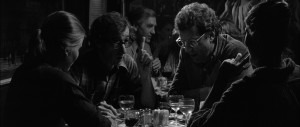 I never had a chance to go to Elaine’s, the famous writers’ haven on the Upper East Side that closed in 2011. But I know its kitschy decor, its tightly packed dining rooms, and even its pay phone. Thanks to Woody Allen.
I never had a chance to go to Elaine’s, the famous writers’ haven on the Upper East Side that closed in 2011. But I know its kitschy decor, its tightly packed dining rooms, and even its pay phone. Thanks to Woody Allen.
He used Elaine’s in his films, from Manhattan (1979) to Celebrity (1998). It was the perfect setting for his characters to discuss everything from art to their failed careers to looking “too incredibly handsome with a cigarette not to hold one.” To me, an aspiring New Yorker a thousand miles away, those scenes transported me to a rarified world of casual intellect, wide-wale corduroy jackets, and the kind of bustle one only seems to find in New York City restaurants, constrained as so many of them are by spaces never intended to hold many people. It was the New York I barely had a chance to live in: the New York of Wallace Shawn and My Dinner With Andre; the New York of Saul Bellow and Mr. Sammler’s Planet; the New York of Allen Ginsburg.
I moved to New York in November 1999, just in time to be able to say I lived here in the 90s. I knew I’d never sit at a table with Gay Talese or Tom Wolfe or George Plimpton, but it was exciting to know that they were dining together, just a few miles from my new apartment on the Lower East Side. I felt very much on the margins — working as a fact-checker, living in a neighborhood once described to me by a native New Yorker as “a little further downtown than anyone wants to go,” and without many friends with whom to have smart, spontaneous conversations over a bottle of wine. But I had arrived in New York, and that was the first step.
Elaine’s closed 12 years later, and for most of that time I didn’t give it much thought. I was too busy building my own writing career, one that exists in the 21st Century, not the one inhabited by Shawn, Bellow, Plimpton, and Wolfe. I do my work on a MacBook Air, mostly from my apartment, and send it to editors all around the country. There are no three-martini lunches, and very few impromptu discussions about life and art over plates of mediocre pasta. The world has changed.
And yet, Elaine’s is about to reopen. Not as “Elaine’s,” but under a far more conspicuous name: “The Writing Room.” Its new owners, a couple in their late 30s and early 40s, want to revive the institution created by Elaine Kaufman 50 years ago. They want to see today’s writers gather at its tables to discuss their work and have their own smart, spontaneous conversations over bottles of wine. They want the old patrons of Elaine’s there, too. Perhaps like me, they feel that they missed out on something the first time around, and this is their chance to experience it for themselves.
Except it’s impossible. As Gay Talese said in a recent interview with the Times, even if the new owners do a great job, that’s beside the point. “Elaine didn’t do it well,” he said, adding that he doesn’t “remember anything at Elaine’s that worked. Except for Elaine.”
In other words, you can’t fake authenticity. Elaine died, her restaurant closed, and many of the luminaries that made the place famous are gone too. And many of those who are still alive are no longer household names.
Two years ago, I went to an outdoor book fair in downtown Brooklyn. I’d never heard of most of the writers who were there, though many had long lines of people waiting for autographs. From a distance, I saw Wallace Shawn, sitting alone, and not a single person was waiting to talk to him. I approached him feeling nervous and a little starstruck, even though I’d passed him on the street numerous times and once even sat near him at a Starbucks in Midtown. I said, “How are you, Mr. Shawn?” and he smiled in that wry, goofy way that only Wallace Shawn can smile. We talked for about a minute, I purchased a collection of new essays he had just published, and he shook my hand. As I walked away, I felt as if I’d just brushed up against the New York I always wanted to live in, and then it was gone again.
New York is getting prohibitively expensive, Elaine’s closed, and writers — what’s left of them — work on sleek little devices from anywhere they want. Smoking in restaurants is banned now, too; very few people know who Wallace Shawn even is, or if they do they just think of him as a B-list actor who repeatedly squealed the word “Inconceivable!” in The Princess Bride; and wide-wale corduroy jackets are no longer in style.
“Goodbye to all that,” Joan Didion famously wrote. The Writing Room won’t bring it back.
